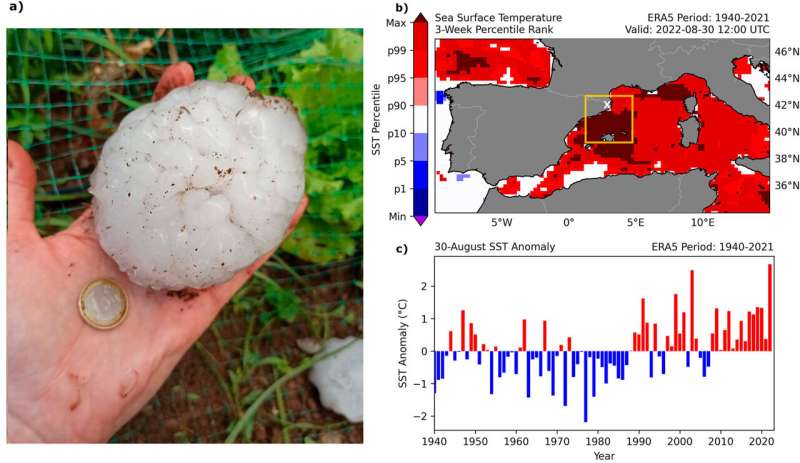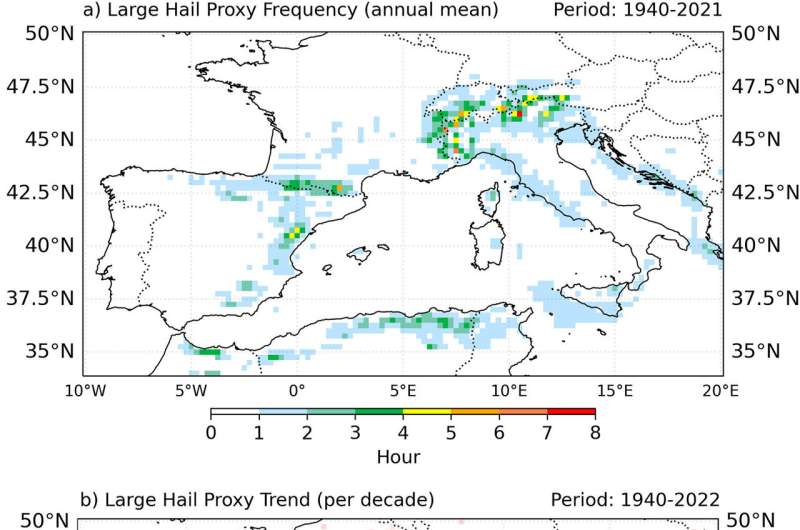April 2, 2024 feature
This article has been reviewed according to Science X's editorial process and policies. Editors have highlighted the following attributes while ensuring the content's credibility:
fact-checked
peer-reviewed publication
trusted source
proofread
Spain's giant hail event worsened by marine heat waves, study finds

Hail is a semi-frequent visitor to winter, and occasionally summer, seasons across the globe and tends to pass by in a short but sharp downpour that can often be overlooked. However, sometimes these meteorological phenomena are hard to ignore. This was the case on 30 August 2022, when Gerona, north-eastern Spain, experienced a severe event in which individual hailstones reached a massive 12cm—the largest ever documented in the country. This led to serious damage to buildings, cars and agricultural areas, as well as 67 injuries and one fatality.
Untangling the cause of this unusually extreme hail event is at the heart of new research published in Geophysical Research Letters. Professor Maria Luisa Martin, of Universidad de Valladolid, Spain, and colleagues investigated the role a record-breaking marine heat wave had in exacerbating the hail storm.
The Iberian Peninsula experienced a sea surface temperature increase of an average 3.27°C protracted over six weeks in the summer of 2022, the highest on record. The research team found that atmospheric convective energy reached unprecedented levels, thus alongside moisture from a warm ocean, enhanced supercell (storms with vertical rotation of rising air currents) development in the Pyrenees, leading to the meteorological phenomenon of hail.
To explore this further, the scientists used a dataset of >280 documented supercells from 2011 to 2022 (with 57 citing large hailstones >5cm diameter, and four giant hailstone events where they exceed 10cm diameter) to simulate the hail event both with and without the influence of a marine heat wave in the Mediterranean Sea. Increased sea surface temperature is known to be one of many consequences of global warming, and it has a direct impact on the frequency and intensity of prolonged (>5 days) heat wave events.

While hailstone events are seemingly sporadic, the simulations determined that large hail storms could take place for ~4 hours/year. The Maestrazgo region of north-eastern Spain was shown to be most susceptible to these large hail events in the country as it is a focus point for supercell formation.
Furthermore, the warmer Mediterranean Sea is determined to be a factor of anthropogenic-induced temperature increases, an additional variable included in the simulations. Modeling pre-Industrial climate, marine heat waves were deemed to be significantly less frequent and severe, therefore highlighting the role global warming has on extreme meteorological events. Indeed, some of the most severe hail storm events on record in the dataset occurred within the last three years up to 2022.
Overall, Professor Martin and the team identified a significant reduction in conditions conducive to a hail event when marine heat waves were reduced/removed from the models, specifically a decline in convective energy and weaker updrafts hindering supercell development.
This research is important as it is a cautionary tale of how continued climate change will not only increase the likelihood of marine heat waves, but also other elements of Earth's interconnected cycles. Consequently, there may be more unforeseen meteorological events to come, with alarming environmental, social and economic impacts.
More information: M. L. Martín et al, Major Role of Marine Heatwave and Anthropogenic Climate Change on a Giant Hail Event in Spain, Geophysical Research Letters (2024). DOI: 10.1029/2023GL107632
Journal information: Geophysical Research Letters
© 2024 Science X Network





















